- Home
- Media Kit
- Current Issue
- Past Issues
- Ad Specs-Submission
- Ad Print Settings
- Reprints (PDF)
- Photo Specifications (PDF)
- Contact Us

![]()
ONLINE

The New Doha Port Project
Editors’ Note
A licensed private pilot, Abdulaziz Mohammed Al-Noaimi holds diplomas in both air traffic control and telecommunications, as well as a BSc in business administration. In addition to his current post with the Civil Aviation Authority, which he assumed in 2002, Al-Noaimi serves as Chairman of the New Doha International Airport Project Steering Committee and of the New Doha Port Project Steering Committee, and he is a member of the board of directors for Qatar Airways and Qatar National Hotels Company. He previously served as the Director of Doha International Airport and as Director of Qatar’s Civil Aviation Authority’s Department of Meteorology. Al-Noaimi is also the Executive Chairman of the Arab Civil Aviation Commission.
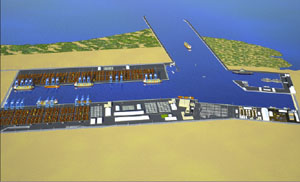
Renderings of the planned New Doha Port project
Can you share why His Highness the Emir issued a decree for the establishment of the New Doha Port?
Qatar is experiencing tremendous growth in all aspects of infrastructure and industrial development. His Highness the Emir is implementing a strategic development of Doha and Qatar over the next 10 to 15 years. In order to achieve this objective, there will have to be significant growth in the importation of raw materials and goods into the country. While the oil and gas industry requirements are served by the ports at Mesaieed and Ras Laffan, the commercial and business sector is served primarily by the Port of Doha. The existing port is reaching its maximum throughput capacity, and its geographic location is not compatible with the longer-term development planned for the city.
The creation of a new commercial port, outside of the city’s boundaries, will provide a world-class port facility that will cater to the future growth of the country. It will allow all of the operations of the existing port to be relocated and will provide additional capacity and room for future growth. The transfer of the existing port operations is one of a number of measures being taken to help alleviate the traffic congestion on the roads of Doha. The new port will be positioned to maximize the synergy with future industrial areas and economic zones, as well as the existing industrial city of Mesaieed.
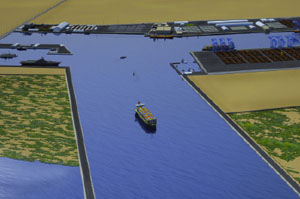
Where will the new port be located? When will it be operational? And what international specifications related to seaports will be adhered to when construction of the New Doha Port takes place?
The new port will be located in the coastal strip north of Mesaieed and south of Al Wakra and will occupy 20 square kilometers of this currently unused land. This land forms part of the recently designated Economic Zone 3. The current plan is to bring the new port into operation in 2014, with operations of the existing port being progressively transferred to the new port as the various terminals are completed.
The new port will be a world-class facility and, as such, will be designed and constructed to the highest international standards. It will be fully compliant with ISPS [the International Ship and Port Facility Security Code], which became enforceable in 2004 and applies to ships on international voyages, including passenger ships, cargo ships of gross tonnage of 500 metric tons, and greater mobile offshore drilling units, and the port facilities serving these vessels.
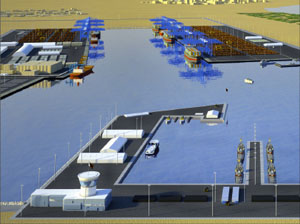
What kinds of capacity and capabilities will the new port have?
The new port will be developed in phases, with the first phase scheduled for completion in 2014. This phase includes new dedicated terminals for containers, general cargo, bulk grain, vehicle carriers, livestock, and offshore supply support operations and a facility for the Qatar Coast Guard and Navy.
The new container terminal is one of three planned for the port and will have a throughput capacity of two million TEUs [twenty-foot equivalent units, which is approximately seven times the capacity of the existing Doha Port in its current configuration. The ultimate capacity of the new port will be on the order of 12 million TEUs.
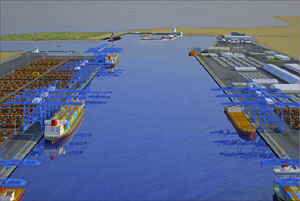
What are your projections for the New Doha Port, insofar as how it will impact Qatar’s economy and trade both regionally and globally?
The location of the new port has been carefully selected, following extensive studies, and will be an integral part of the new economic zone, as well as have direct links to the industrial city of Mesaieed. The increased capacity and world-class facilities of the new port will act as a catalyst for the economic growth of the area and the country as whole. It will be connected to the major transportation routes, which are being planned as a part of the master plan for Qatar. The growth of the port and industries in the surrounding areas will provide opportunities for employment, and as these businesses grow, there will also be a requirement to develop residential and recreational areas, schools, hospitals, and shopping malls.
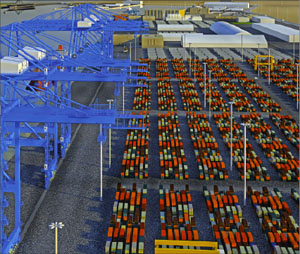
In what ways do you see the New Doha Port, upon completion, being unique and distinct from all the leading global ports around the world?
The vision for the New Doha Port is for it to be a world-class facility that will be a leader in state-of-the-art technology. In addition to providing all of the facilities required and demanded of modern ports, the new port must reflect Qatar’s own unique culture. This will be reflected in the design of the port, the architecture of the main buildings, the development of the adjacent land areas, and the environment in which the port will be developed.
What else should our readers know about the New Doha Port?
I would like to take this opportunity to let your readers know that the government of the State of Qatar will ensure that the environmental impacts of the project, during both construction and the subsequent operation of the port, are mitigated to the maximum extent possible. It has already been recognized that the location of the new port is close to environmentally sensitive coastal areas. Environmental-impact-assessment studies form an integral and important part of the project, and these studies will help us define, specify, and implement appropriate mitigation measures through all stages of the project. Representatives of the Ministry of Environment are already working closely with our consultants and other stakeholders in the project.